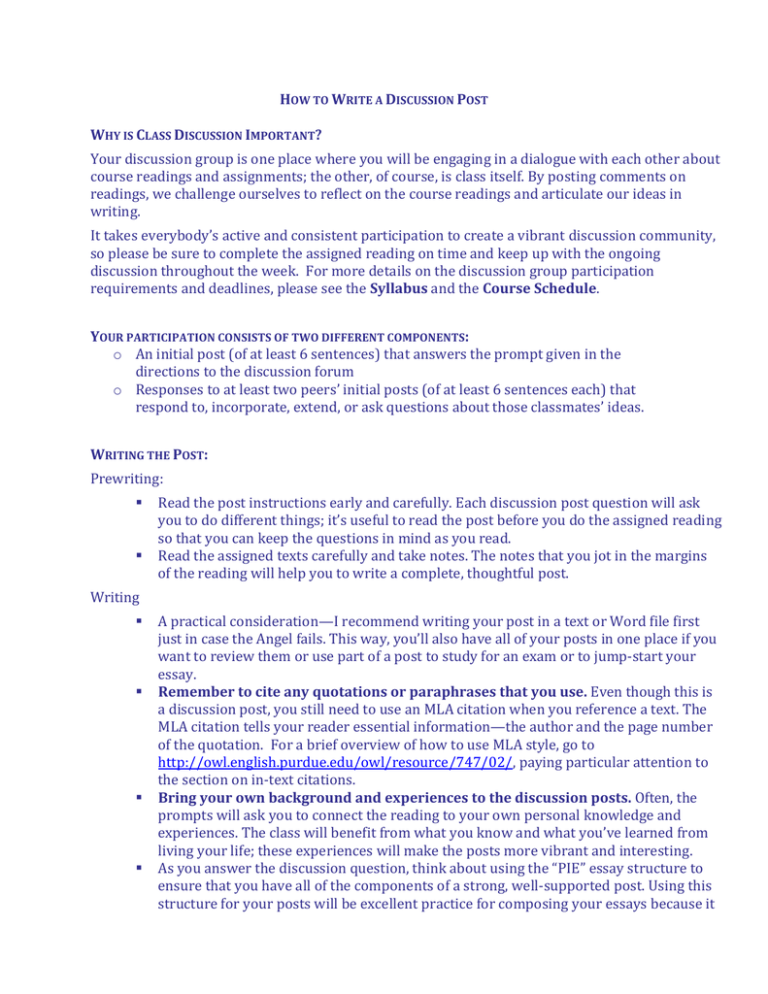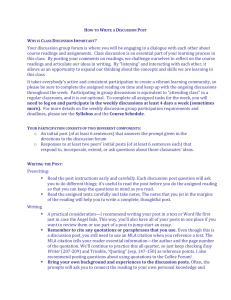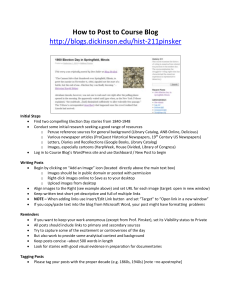H W D P
advertisement

HOW TO WRITE A DISCUSSION POST WHY IS CLASS DISCUSSION IMPORTANT? Your discussion group is one place where you will be engaging in a dialogue with each other about course readings and assignments; the other, of course, is class itself. By posting comments on readings, we challenge ourselves to reflect on the course readings and articulate our ideas in writing. It takes everybody’s active and consistent participation to create a vibrant discussion community, so please be sure to complete the assigned reading on time and keep up with the ongoing discussion throughout the week. For more details on the discussion group participation requirements and deadlines, please see the Syllabus and the Course Schedule. YOUR PARTICIPATION CONSISTS OF TWO DIFFERENT COMPONENTS: o An initial post (of at least 6 sentences) that answers the prompt given in the directions to the discussion forum o Responses to at least two peers’ initial posts (of at least 6 sentences each) that respond to, incorporate, extend, or ask questions about those classmates’ ideas. WRITING THE POST: Prewriting: Read the post instructions early and carefully. Each discussion post question will ask you to do different things; it’s useful to read the post before you do the assigned reading so that you can keep the questions in mind as you read. Read the assigned texts carefully and take notes. The notes that you jot in the margins of the reading will help you to write a complete, thoughtful post. Writing A practical consideration—I recommend writing your post in a text or Word file first just in case the Angel fails. This way, you’ll also have all of your posts in one place if you want to review them or use part of a post to study for an exam or to jump-start your essay. Remember to cite any quotations or paraphrases that you use. Even though this is a discussion post, you still need to use an MLA citation when you reference a text. The MLA citation tells your reader essential information—the author and the page number of the quotation. For a brief overview of how to use MLA style, go to http://owl.english.purdue.edu/owl/resource/747/02/, paying particular attention to the section on in-text citations. Bring your own background and experiences to the discussion posts. Often, the prompts will ask you to connect the reading to your own personal knowledge and experiences. The class will benefit from what you know and what you’ve learned from living your life; these experiences will make the posts more vibrant and interesting. As you answer the discussion question, think about using the “PIE” essay structure to ensure that you have all of the components of a strong, well-supported post. Using this structure for your posts will be excellent practice for composing your essays because it allows you to practice the significant steps of paragraph writing. The components of the PIE structure are explained below: o Point: The “point” tells your reader what you’re going to write about and why that thing matters. The point is the post’s reason for being. It may take you awhile to figure this out sometimes, which means that you may edit the “point” when you reread your post to check for clarity and grammar. You’ll often find yourself doing this in essays, too—we often understand what our point (or thesis) is after we’ve written a piece, and then we have to go back and put it at the beginning so that our reader knows what we’re trying to say. o Illustration (Evidence): The illustration provides an example—in this course, usually an example from the text or from your own experience—that helps to support the point that you’ve made. (I tend to think of this part of the “PIE” as “Evidence” rather than “Illustration,” but that poses obvious problems for the acronym!) o Explanation/Evaluation: Make sure to fully explain the Illustration or Evidence that you’ve given above. Evidence doesn’t speak for itself—you have to interpret it for the reader! Focus on specific words or rhythms from the text or tell us why this illustration or piece of evidence matters. I think of this as the fun part of the post because you get to speak with authority and closely examine another person’s words or your own experiences. After Writing: Proofread! These posts are definitely less formal than your final essays, but you still want to make sure that they communicate your point in a clear fashion and that they are carefully checked for spelling and grammar. Checking posts is excellent practice for your everyday life—well-written, proofread e-mails or memos will make you look more professional and polished! RESPONDING: You will need to respond to at least two posts per Discussion Post assignment, and each response should be at least six sentences long. This length will compel you to think more deeply and to articulate yourself more fully. Some Potential Responses: Agreeing – and providing a parallel example or specific reason for your agreement At times, you will read a post that you agree with completely. The ideas will all make complete sense to you, and the example will be spot on. In these cases, you can write, “I agree with you completely . . .,” but always add an illustration and explanation of why you agree (see the PIE structure above). At this point, “I agree with you completely” becomes “I agree with you because . . .” Agreeing—But with a Difference It’s possible that someone’s post really resonated with you, but you have a slightly different opinion or point of view. Maybe you can think of a way to complicate or deepen the ideas in the post. Maybe you had a similar experience but came to a different conclusion. Maybe you’ve had vastly different experiences but find yourself agreeing with the post’s conclusion. “Agreeing with a Difference” is a fantastic way to engage in meaningful dialogue, and it’s a wonderful way to practice that analytical writing that you’ll be doing in your essays. Respectfully Disagreeing At times, you will have a different opinion than one of your classmates, and articulating that disagreement clearly and respectfully will allow both you and your classmates to think more critically about the situation at hand. When you do disagree with someone, it’s helpful to provide context (your own situation or point of view) and evidence—a fact, an anecdote, a carefully constructed argument. Remember that the purpose of discussion isn’t to “win” or to have the “right” answer; rather, it’s to help us explore and examine the various different opinions to expand our thinking about the course readings and concepts. MY ROLE These discussion posts will be a way for you to communicate with one another and work through your ideas about the reading. Therefore, I will be reading (and grading) all of the discussion posts, but I will act as a “Guide on the Side” during these posts rather than a judge or facilitator. You will hear from me—but in a limited fashion. Your responses to one another are the most important component of these discussions. GRADING Scoring Rubric for Discussion Posts Original Post Point and Explanation/Evaluation 12 points 4 points Do you make a point and then explain why you have come to that think that way? Use of Evidence/Illustration 4 points Style and Mechanics 4 points Do you support your claims with examples from the texts or from your life? Is the post written in a clear, readable style? Is the post edited for spelling errors? Responses Is your response thoughtful and detailed? Do you respond to specific language or information from the post? 4 points x 2 ____________________________________________________________________________ Total 20 points NAVIGATING ONLINE DISCUSSION: Civility: Always remember to treat each other with respect! Intellectual debate is a healthy and exciting part of any learning community. It's okay to disagree with each other, but be mindful of the tone that you use. Proofread, but don’t agonize over each posting! For some of you, I know it can feel intimating to post something in writing. While we want thoughtful reflections, it's important to keep in mind that your discussion postings are “thoughts in progress”-they're not meant to be polished essays! The discussion posts are places to try out ideas, and these ideas can be experimental. I DO want you to practice structure until it becomes second nature, but I don’t want you to censure your ideas. Allow yourself to “think aloud” with your group members as you would in an oncampus discussion. Don't stay silent because you feel like everything you post has to be absolutely profound. As stated above, participating in intellectual exchange with others is critical to our learning because it helps us explore, develop, and clarify our own ideas.



